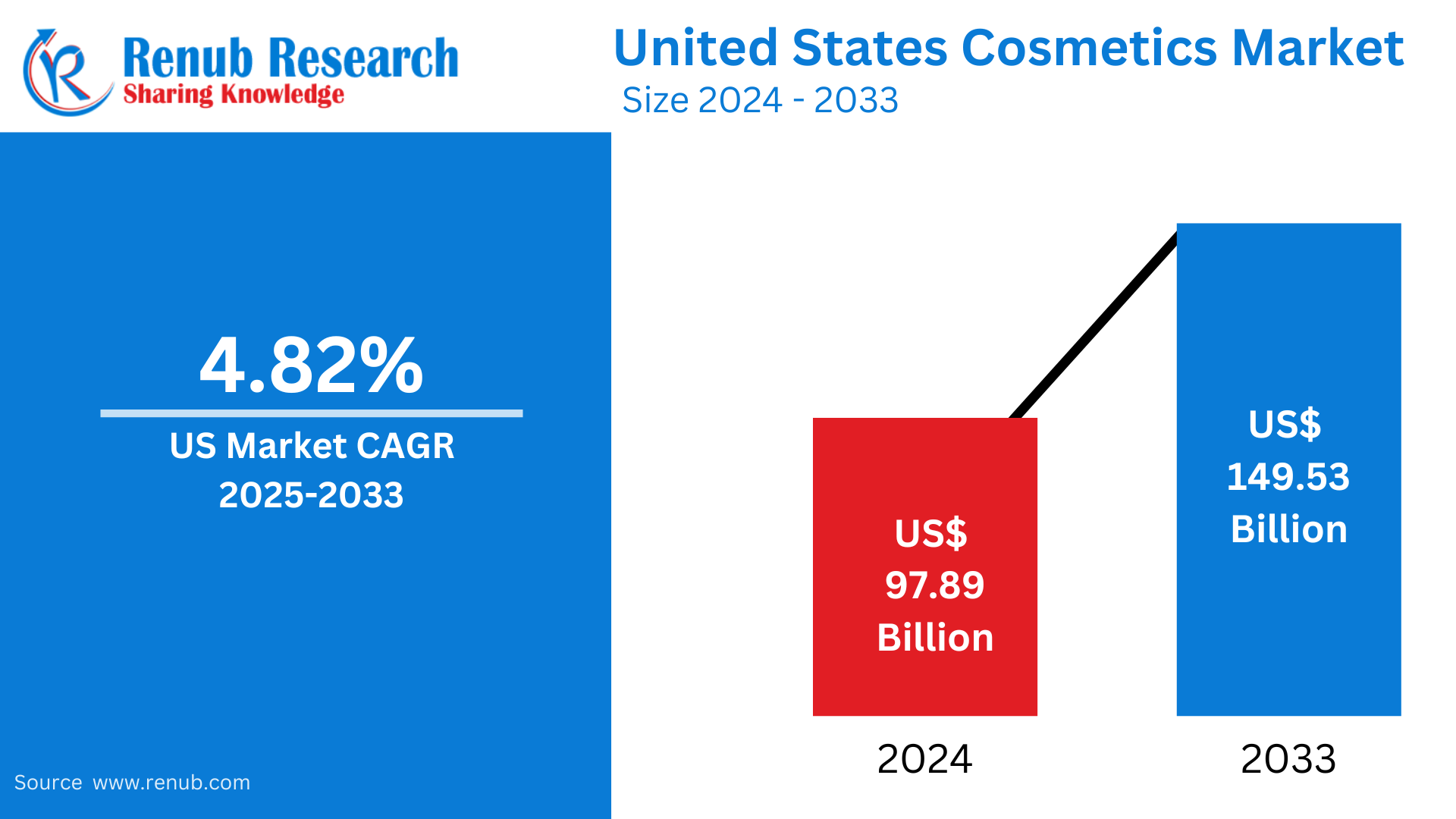United States Cosmetics Market Trends & Summary
Overview of the United States Cosmetics Market:
The United States Cosmetics Market is set to reach an impressive value of US$ 149.53 billion by 2033, growing from US$ 97.89 billion in 2024. This represents a steady compound annual growth rate (CAGR) of 4.82% from 2025 to 2033. This growth is driven by key factors like the increasing demand for premium beauty products, greater skincare awareness, and the rising preference for green cosmetics. These trends are supported by advances in e-commerce and digital marketing, making it easier for consumers to access new and sustainable cosmetic products.
Key Drivers of Market Growth:
- Consumer Demand for Clean Beauty Products: The clean beauty trend, focusing on products free from harmful chemicals and toxins, continues to shape consumer purchasing decisions. Brands offering "clean," "vegan," or "cruelty-free" products are becoming increasingly popular, particularly among Millennials and Gen Z. About 43% of this demographic prefers natural skincare, signaling a shift toward healthier, more transparent beauty standards.
- Social Media and E-Commerce Influence: Platforms like Instagram, TikTok, and YouTube play a central role in shaping beauty trends and consumer preferences. Influencers and beauty vloggers drive product recommendations, reviews, and tutorials, impacting purchasing behavior. Moreover, e-commerce platforms like Amazon are becoming key starting points for beauty product searches. Data from Tinuiti (June 2023) shows that 37% of US beauty shoppers start their search on Amazon, with other platforms like Walmart and retailer websites trailing behind.
- Personalization and Inclusivity: There is a marked demand for personalized and inclusive beauty products that cater to diverse skin tones, types, and individual needs. Brands are responding by developing customized skincare routines and foundations in a wider variety of shades. This growing demand for products tailored to individual concerns is pushing beauty companies to create highly personalized beauty experiences for their customers.
Challenges in the United States Cosmetics Market:
- Regulatory and Compliance Challenges: Companies must navigate complex regulatory frameworks set by the FDA and other regulatory bodies, particularly as the demand for "organic," "natural," and "cruelty-free" products grows. This creates a balance between product innovation and adherence to safety standards, which can be resource-intensive for companies.
- High Competition and Market Saturation: The US cosmetics industry is highly competitive and saturated, with numerous players vying for consumer attention. Smaller brands may struggle to differentiate themselves from established giants with substantial marketing budgets. The key to success in this environment is continuous innovation, investment in marketing, and leveraging differentiated products to maintain customer interest.
New Publish Reports
· Cosmetics Market Size and Share Analysis - Growth Trends and Forecast Report 2025-2033
· Halal Cosmetics Market Size and Share Analysis - Growth Trends and Forecast Report 2025-2033
Market Segmentation:
- By Product Type:
- Skin and Sun Care Products
- Hair Care Products
- Deodorants and Fragrances
- Makeup and Color Cosmetics
- Others
- By Gender:
- Men
- Women
- Unisex
- By Distribution Channel:
- Supermarkets/Hypermarkets
- Specialty Stores
- Pharmacies
- Online Sales
- Others
Key Companies in the U.S. Cosmetics Market:
Several leading companies are shaping the future of the U.S. cosmetics market. These include:
- Coty Inc.
- Procter & Gamble
- The Estee Lauder Companies Inc.
- Colgate-Palmolive Company
- Johnson & Johnson Services Inc.
- Revlon Inc.
- Mary Kay Inc.
Each of these companies is focusing on product innovation, expanding their digital footprint, and responding to emerging trends like clean beauty and sustainability.
Consumer Trends in the United States Cosmetics Market:
- Haircare: There's a growing preference for high-quality, natural haircare products, particularly those containing organic oils, vitamins, and plant extracts. The rise of individualized haircare solutions is being driven by consumer desire for products tailored to specific hair concerns.
- Makeup and Color Cosmetics: The demand for long-lasting beauty products with skin benefits is increasing. Inclusivity is a central theme in product development, with brands catering to a wide array of skin tones.
- Pharmacies: More beauty and skincare products are being sold through pharmacies, which now carry premium, dermatologist-approved brands. This reflects a broader trend towards self-care and health-conscious beauty products.
Conclusion:
The United States Cosmetics Market is on a robust growth trajectory, driven by rising consumer demand for clean beauty, personalized products, and inclusive beauty solutions. E-commerce and social media are reshaping how consumers discover and purchase products. However, companies face challenges such as regulatory compliance and intense market competition, making it essential to continuously innovate and cater to evolving consumer preferences.




